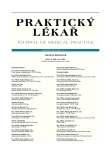-
Medical journals
- Career
Risk factors for cardiovascular diseases in regular yoga practitioners in comparison with general population
Authors: V. Čajka 1; E. Sovová 2,3; D. Pastucha 2; I. Benušová 3; P. Dupalová 3; J. Zapletalová 4; K. Langová 4; D. Horáková 5
Authors‘ workplace: Ordinace praktického lékaře Nový Malín Lékařská fakulta Univerzity Palackého a Fakultní nemocnice Olomouc 1; Klinika tělovýchovného lékařství a kardiovaskulární rehabilitace, Přednostka: doc. MUDr. Eliška Sovová, PhD., MBA. 2; I. interní klinika– kardiologická, Přednosta: doc. MUDr. Miloš Táborský, CSc., FESC, MBA 3; Ústav lékařské biofyziky, Přednostka: prof. RNDr. Hana Kolářová, CSc. 4; Ústav preventivního lékařství, Přednostka: doc. MUDr. Helena Kollárová, PhD. 5
Published in: Prakt. Lék. 2012; 92(1): 41-44
Category: Of different specialties
Overview
Objectives:
The aim of this study is to assess the influence of regular yoga exercise on the occurrence of risk factors for cardiovascular diseases and metabolic syndrome in persons practicing yoga in comparison with the general population.Subjects:
We examined 58 persons (17 males, 41 females), ages 26–68 years, who had been practicing yoga daily according to the Yoga in Daily Life system for at least 2 years. The results of the Yoga in Daily Life group (YIDL) were compared with the results of a general population (GP) group, which included 58 persons (17 males, 41 females), ages 28–65.Results:
The results of the YIDL group were significantly better than the results of the GP group in the following parameters: BMI (P = 0.008), systolic BP (P = 0.011), diastolic BP (P = 0.033), and triacylglycerols (P = 0.003). There were no significant changes in the other anthropometric parameters followed.Conclusion:
The occurrence of RF of CVD is lower in persons regularly practicing yoga than in the general population.Key words:
risk factors, cardiovascular disease, metabolic syndrome, yoga, prevention, treatment.
Sources
1.Innes, K.E, Bourguignon, C., Pylor, A.G. Risk indics associated with the insulin resistance syndrome, cardiovascular disease, and possible protection with yoga: a systematic review. J. Am. Board. Fam. Med. 2005,18(6), p. 491-519.
2. Innes, K.E, Vincent, H.K. The influence of yoga – based programs on risk profiles in adults with type 2 diabetes mellitus: a systematic review. Evid. Based Complement. Alternat. Med. 2007, 4(4), p. 469-486.
3. Gordon, L.A., Morrison, E.Y., McGrowner, D.A. et al. Effect of exercise therapy on lipid profile and oxidative stress indicators in patiens with type 2 diabetes. BMC Complement. Altern. Med. 2008, 13, p. 8-21.
4. Streeter, C.C., Whitfield, W.H., Owen, L. et al. Effects ofy oga versus walking on mood, anxiety, and brain GABA levels: a randomized controlled MRS study. J. Altern. Complement. Med. 2010, 16(11), p. 1145-1152.
5. Sovová, E., Kaletová, M., Nakládalová, M. a kol. Vliv cílené intervence na výskyt rizikových faktorů kardiovaskulárních onemocnění u zdravotnických zaměstnanců. Vnitř. lék. 2006, 5, s. 21-25.
6. Maheshwarananda, P.S. Yoga in daily life – the system. Vienna: Ibera Verlag/EUP, 2000.
7. Sundar, S., Agrawal, S.K., Singh, V.P. et al. Role of yoga in management of essentials hypertension. Acta Cardiol. 1984, 39(3), p. 203-208.
8. Murthy, S.N., Rao, N.S, Nandkumar, B., Kadan, A. Role of naturopathy and yoga treatment in management o fhypertension. Complement. Ther. Clin. Pract, 2011, 17(1), p. 9-12.
9. Cohen, D.L., Bloedon, L.T., Rothman, R.L. et al. Iyengaryoga versus enhanced usual care on blood pressure in patiens with prehypertension to stage I hypertension: a randomized controlled trial. Evid. Based Complement. Alternat. Med. Published online 2011, February 14.doi:10.1093/ecam/nep130. Dostupnénahttp://www.ncbi.nlm.nih.gov/pmc/articles/PMC3145370/?tool=pubmed.
10. Bharshankar,J.R.,Bharshankar, R.N.,Deshpande, N. et al. Effect of yoga on cardiovascular system in subjects above 40 years. Indian J. Physiol. Pharmacol. 2003, 47(2), p. 202-206.
11. Gokal, R., Shillito, L., Maharaj, S.R. Positive Impact of yoga and pranayam on obesity, hypertension, blood sugar and cholesterol: a pilot assessment. J. Altern. Complement. Med. 2007, 13(10), p. 1056-1058.
12. Kosuri, M., Sridhar, G.R. Yoga practice in diabetes improves physical and psychological outcomes. Metab. Syndr. Relat. Disord. 2009,7(6), p. 515-517.
13. Bijlani, R.L., Vempati, R.P., Yadav, R.K. et al. A brief but comprehensive live style education program based on yoga reduces risk factors for cardiovascular disease and diabetes mellitus. J. Altern. Complement. Med. 2005, 11(2), p. 267-274.
14. McIver, S., O’Halloran, J.P., McGartland, M.The impal of hathayoga on smoking behavior. Altern. Ther. Health Med. 2004, 10(2), p. 22-23.
15. Sharma, M., Corbin, D.E. A preliminary study of the effects of an innovative social cognitive theory - driven, yoga – based behavioral intervention on smoking cessation. Californian J. Health Promot. 2006, 4(4), p. 63-76.
Labels
General practitioner for children and adolescents General practitioner for adults
Article was published inGeneral Practitioner

2012 Issue 1-
All articles in this issue
- Basics of social cognitive and affective neuroscience; XIII. Creativity
- Strategy of antiaggregation treatment after percutaneous coronary interventions
- Potentially inappropriate (risky) drugs at geriatric patients Expert consensus for the Czech Republic 2012
- Economic burden of alcohol abuse
- Problems of colorectal carcinoma in primary care
- Current role of endoscopic ultrasound investigation in the diagnosis of pancreatic diseases – our experiences
- Risk factors for cardiovascular diseases in regular yoga practitioners in comparison with general population
- A survey of motivational factors in non-medical health professionals
- Psychoactive substances abuse and diabetes mellitus
- General Practitioner
- Journal archive
- Current issue
- Online only
- About the journal
Most read in this issue- Current role of endoscopic ultrasound investigation in the diagnosis of pancreatic diseases – our experiences
- Psychoactive substances abuse and diabetes mellitus
- Potentially inappropriate (risky) drugs at geriatric patients Expert consensus for the Czech Republic 2012
- A survey of motivational factors in non-medical health professionals
Login#ADS_BOTTOM_SCRIPTS#Forgotten passwordEnter the email address that you registered with. We will send you instructions on how to set a new password.
- Career

